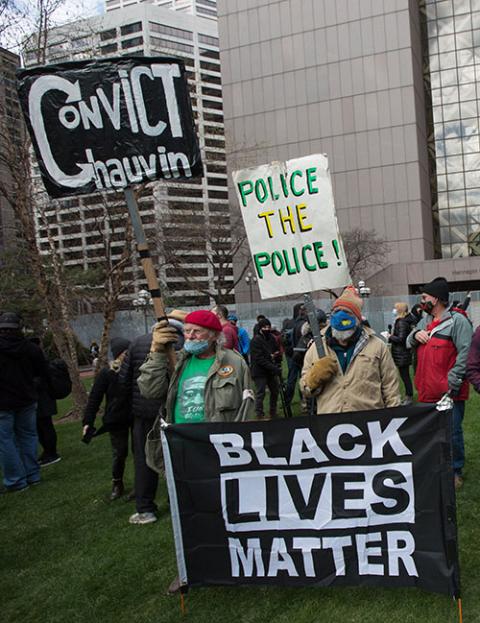
Investigators work at the scene where Ma'Khia Bryant, a 16-year-old Black girl, was fatally shot by a police officer April 20. (CNS/Reuters/Gaelen Morse)
How long must we continue to lament, "How long, O Lord?" (Psalm 13), in the wake of each additional police killing of a Black person or other person of color and each additional mass shooting?
As a theological ethicist possessing prior professional experience in law enforcement, in both corrections and policing, I am currently trying to write two books: one on policing and one on guns. For each, I constantly must revise and update the latest names of persons killed and places where the killings happened. I even had to do so this past week just for this article. I can't keep up.
But names are important, and we must say them, even when we cannot mention all of them: Daunte Wright, George Floyd, Breonna Taylor, Eric Garner and Michael Brown. And the names of cities where mass shootings have occurred in schools, places of worship, and malls similarly come readily to mind: Indianapolis, Aurora, Parkland and Newtown.
A database updated by The Washington Post since 2015 reveals approximately 1,000 fatal shootings by police officers in the U.S. each year, and there are significant differences concerning race and ethnicity. Among Black Americans, the rate of fatal police shootings between 2015 and March 2021 stood at 35 per million of the population, while for white Americans, the rate stood at 14 fatal police shootings per million of the population.

A person in Denver is seen at a George Floyd mural April 20 after jurors issued their verdict convicting former Minneapolis police officer Derek Chauvin of second-degree unintentional murder, third-degree murder and second-degree manslaughter in the death of Floyd. (CNS/Reuters/Kevin Mohatt)
It should also be mentioned that, in 2019, the FBI reports 48 law enforcement officers were feloniously killed. The FBI also notes that around 5.1% of cops feloniously killed between 2002 and 2011 were killed by their own guns that were taken from them, a percentage significantly lower than the nearly 20% during the 1980s.
According to the Gun Violence Archive, which defines a mass shooting as firearm violence resulting in at least four people being injured or killed by a gun, excluding the perpetrator, within approximately the same location, there have been 152 mass shootings so far in 2021 in the U.S.
Although the number of mass shootings are increasing each year, they are a fraction of annual gun deaths. Indeed, there are almost 40,000 intentional and unintentional gun deaths annually, with roughly 90 daily and 10 of them being children, and around two-thirds of these gun deaths are suicides.
These deaths are an epidemic rather than a pandemic. COVID-19 is the latter because it spans national borders and continental boundaries. Police killings of Black people and other persons of color, and mass and other gun shootings are an epidemic with interrelated causes that are relatively unique to the U.S.: racism, militarism, toxic masculinity, and what Presbyterian pastor James E. Atwood calls "gundamentalism."
Advertisement
When I first wore a badge in a large metropolitan area as a blue-collar, white 19-year-old male working my way through community college in 1984, I held these and other "isms." I also truly desired to "serve and protect" people. As a Christian, I recognized firsthand the chasm between my experiences on the job and the peace I glimpsed in the sanctuary during the liturgy.
I am glad I felt uncomfortable back then when one of my fellow white officers during roll call proudly displayed to us a thank-you note and flag he had received from the government of South Africa after he had expressed his support of apartheid. Not only did I witness excessive force, brutality and racism by law enforcement officers and by the criminal justice system, I saw the violence and injustices that people committed against each other and even themselves.
Sadly, sometimes I had to use force (thankfully, not lethal force); sometimes I was on the receiving end of fists (on occasion, even urine and feces) hitting me. But I should add that the job also involved officers helping people in need, searching for lost loved ones, rescuing persons in dangerous situations, stopping the bleeding from injuries sustained in a car accident, and persuading someone not to commit suicide.
Policing as we know it today is but a mirror reflection of much of the wider U.S. culture. Few nations have police as armed as ours; few nations have citizens as armed as ours. Criminologists Peter Scharf and Arnold Binder observe that in "the mythology of police work," the gun is viewed as "the primary symbol of law enforcement," the "tool of the trade" and the "culturally defined essence of police work."

Gun rights advocates attend a rally in Richmond, Virginia, Jan. 20, protesting plans by the state's Democratic leadership to pass gun-control legislation. (CNS/Reuters/Jim Urquhart)
At least, this has become the case with police in the U.S., where the public, especially due to decades of TV police dramas and action films, has come to share this vision of guns and policing.
In a country where the more than 350,000,000 guns are owned by 30% of its 332,542,637 citizens — and 29% of those own five or more guns — the gun appears pivotal not only for police but for a noteworthy portion of the population, especially those who regard it as an emblematic American right enshrined in the Second Amendment.
Although I was trained to use a gun, and although I personally have owned a few firearms, I have never felt at ease in doing so. Indeed, it was the emphasis on the use of force in law enforcement that made my conscience, as a follower of Jesus, uneasy, and its exacerbation by racism came to bother me even more.
In the Catholic moral tradition, there are resources offering prescriptive guidance for the reforms requisite toward the end of reducing police killings; eliminating disproportionate stops, arrests and killings of Black persons; and minimizing gun deaths in this country. Foundational is the life and dignity of the human person as image of God. This is the basis for the prohibition of direct and intentional killings of innocent human persons, which would be murder. Hence the church's stand against direct abortion and euthanasia.
Indeed, in the teachings of St. Pope John Paul II, Emeritus Pope Benedict XVI and Pope Francis, this respect for human dignity and life has become so pronounced that it now extends to the teaching that even the execution of a guilty human person is "inadmissible." Moreover, in "Open Wide Our Hearts," the U.S. Catholic bishops add that the "injustice and harm racism causes are an attack on human life," and they "unequivocally state that racism is a life issue."
Protection is the top reason given by Americans for owning guns. Although in recent years, Francis has emphasized nonviolence, Catholic teaching does not prohibit the use of force in "legitimate defense" of one's life or the lives of others.
Importantly, this is primarily the right and duty of those who are responsible for others' lives, namely: "those holding legitimate authority have the right to repel by armed force aggressors against the civil community entrusted to their charge." Thus, individual citizens may resort to armed force only when those authorized to protect public safety are absent or cannot arrive on time.

Activists confront state troopers, National Guard members and other law enforcement officers in Brooklyn Center, Minnesota, following an April 13 march in honor of Daunte Wright, 20, who was fatally shot April 11 by a Brooklyn Center police officer who has since resigned. (CNS/Reuters/Nick Pfosi)
The Catechism of the Catholic Church highlights St. Thomas Aquinas's stipulation (taught at one of the police academies I attended): "The act of self-defense can have a double effect: the preservation of one's own life; and the killing of the aggressor ... the one is intended, the other is not." But the defender should not use "more than necessary violence." Lethal force should be used only when one's life, or another's, is threatened.
Although he did not use a gun to do so, Minneapolis police officer Derek Chauvin's killing of Floyd failed to satisfy this expectation. Indeed, disproportionate force calls into question whether the death of the attacker is truly unintended, indeed whether it is instead the result of the defender's "anger, hatred, and vengeance" against the attacker. The death of an aggressor is not to be celebrated but regretted. As the U.S. bishops stated in their 1983 pastoral, "The Challenge of Peace," "the possibility of taking even one human life is a prospect we should consider in fear and trembling."
Ethicist Charles Camosy's "pissed test" thus asks whether the defender would be upset were the attacker only incapacitated rather than to have died; if so, then the defensive action would be morally illegitimate. Perhaps Brooklyn Center, Minnesota, police officer Kimberly Potter's exclaiming, "Oh shit, I just shot him," after realizing she had used her firearm instead of her Taser on Wright would pass this test, so long as she truly meant it and was not merely trying to cover her tracks.
While Catholic moral teaching justifies the protection of self and others as legitimate defense, it also narrows the scope of both police use of force and Americans' right to "bear arms." It does so, moreover, when taking into consideration unintentional killings, which are not always morally unblameworthy. The catechism states that "the moral law prohibits exposing someone to mortal danger without grave reason, as well as refusing assistance to a person in danger," including "if, without proportionate reasons, he has acted in a way that brings about someone's death, even without the intention to do so." Here we find the moral basis for distinguishing between degrees of murder and manslaughter.

People gather near the Hennepin County Government Center in Minneapolis April 20 to await the verdict in the trial of former Minneapolis police officer Derek Chauvin. (CNS/The Catholic Spirit/Dave Hrbacek)
Commentators on the trial of Chauvin rightly referred to "depraved heart murder" vis-à-vis his second-degree murder charge. There is more moral culpability in it than the negligence of manslaughter. In depraved heart murder, the agent's foreseen but unintended action has exhibited a "reckless" and "callous disregard for human life" resulting in death. Keeping his knee on Floyd's neck for more than nine minutes certainly reflected such a callous disregard for his life, especially since Chauvin did not provide medical care or allow others to help do so when it was obvious that Floyd had stopped breathing.
Aquinas also addressed when a person might be morally responsible for foreseen, though unintended, effects that are certain to result from that person's action. In his treatise "On Evil," he considered a scenario in which a branch falls and kills someone as a consequence of a woodcutter's chopping a tree in a forest. If the forest is not regularly traveled by persons, no moral blame is attributed to the lumberjack. The victim's death is unintended, even if it is a foreseen as a somewhat remote possibility.
However, if the forest is regularly traveled by people, the woodcutter is morally culpable. According to Aquinas: "But if evil is always or in most cases associated with the good intrinsically intended, the will is not excused from sin, although the will does not intrinsically intend the evil." We are morally responsible for unintentional effects if these are foreseen as probable or certain.
I worry that the United States' failure to address and reduce the number of police killings, especially the disproportionate rate of killings of Black people and other persons of color, and the increasing number of gun deaths similarly reveals a cultural callous disregard for life. Even if these many thousands of deaths each year are not intended, we foresee that they will happen. If we do not take measures to minimize them, we as a nation are morally culpable.
Alex Vitale, in his The End of Policing, calls not necessarily for the abolition of policing altogether, but a rethinking of the "basic role," "orientation," "mindset," "mission" and "culture" of the police. I would add that the "end" can mean the purpose, goal or telos of policing. And we should do the same with guns.
Vitale writes that we need a "larger vision that questions the basic role of police in society and asks whether coercive government action will bring more justice or less." Same goes for guns: Do so many guns provide more protection or less?
Reforms such as the George Floyd Justice in Policing Act and the Biden-Harris plan to address the gun epidemic make sense and provide a reasonable start, and Catholics should support them. These reforms would provide better public safety for all, including for the police.






